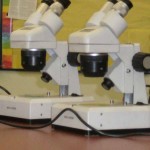 “Where’s Herb!” Is all you heard when you walked into Mrs. Chiavarini’s room. Everyone was frightened, we all wanted Herb back! Whispers filled the air. We had to find Herb, our green Brachiosaurus.
“Where’s Herb!” Is all you heard when you walked into Mrs. Chiavarini’s room. Everyone was frightened, we all wanted Herb back! Whispers filled the air. We had to find Herb, our green Brachiosaurus.
We found a note that the culprit had written, which said “Don’t worry. Herb is in good hands.” It was written in black marker. We didn’t think Herb was in good hands, so we had to find out who took him!
Luckily, Mrs. Chiavarini knew the procedure. We made a list of suspects based on teachers who have been acting suspicious and were still in their classroom during lunch. It was a long list but we narrowed it down to three suspects. The suspects were Mrs. Angelus because she told a student the day before “I’ll be acting suspicious soon.” Mr. Wadness walked in looking and playing with Herb. Miss Varley walked in and said in front of the class, “I like stealing things.”
Mrs. Chiavarini took black markers off the three suspects’ desks. We ran a chromatography test on each of the black markers. Using a coffee filter we drew a line with each marker and dipped the filter in water. We ran the same test with the culprits’ note and the result was … Mrs. Angelus. We kindly asked her if she took Herb and why. Mrs. Angelus explained she was sketching a picture of Herb to help the second graders with their dinosaur projects. She told the class Herb was in good hands and Herb was in Mrs. Mclaughlin’s project room.
Now everyone is very glad that Herb is in safe hands. Cheers filled the room, not one frown on anyone’s face. Once again Forensic Science saves the day!
Do you know what “Forensic Science” is? Well, Chickering 5th graders know.
“Forensic Science is the scientific method of gathering and examining information about the past which is then used in a court of law.” [http://en.wikipedia.org/wiki/Forensic_science 13 Nov 2014]
We know this because Mrs. Antinellus [Atomic A],from the Natick Labs, came to our school to teach us about C.S.I. [Crime Scene Investigation].
We wondered what Atomic A likes about her job as a Forensic Science teacher and what is fun about her job. We asked Atomic A if she had heard of any interesting cases that used Forensic Science to solve them. She said in a ‘hit and run’ accident, they can go back and test the paint on the car that has been left on the other car from being hit. If there is a murder case, the Forensic Scientist uses a blood sample to check DNA, which is compared to a suspect’s’ DNA.
Atomic A likes being an Forensic Science teacher because you can scan blood samples for DNA by a computer. We asked her what her favorite tool was. She likes the DNA test because almost any case can be solved with it. We asked if she always wanted to be a science teacher. She always wanted to be a teacher not necessarily a science teacher. She said she has been a teacher for many years. She was a teacher for 3rd grade, pre-school and ESL [English as a Second Language]. Last we asked her what she liked least about being a Forensic Science teacher. She said her least favorite thing is carrying the heavy supplies to presentations.
All in all we learned that Forensic Science isn’t just science, it’s much more. It’s solving crimes, scanning blood samples, it’s finding crooks, but most importantly, uncovering evidence. Most of all, we think Forensic Science is one of the most appealing jobs in the world.
Reported by: Zach, Kristian and Max



